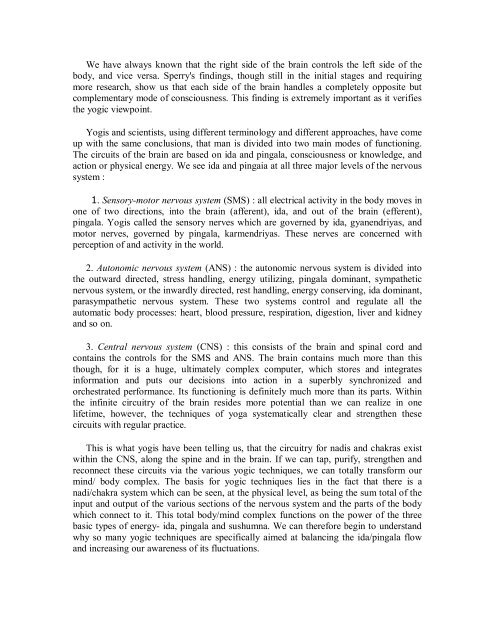Kundalini.Tantra.by.Satyananda.Saraswati
You also want an ePaper? Increase the reach of your titles
YUMPU automatically turns print PDFs into web optimized ePapers that Google loves.
We have always known that the right side of the brain controls the left side of the<br />
body, and vice versa. Sperry's findings, though still in the initial stages and requiring<br />
more research, show us that each side of the brain handles a completely opposite but<br />
complementary mode of consciousness. This finding is extremely important as it verifies<br />
the yogic viewpoint.<br />
Yogis and scientists, using different terminology and different approaches, have come<br />
up with the same conclusions, that man is divided into two main modes of functioning.<br />
The circuits of the brain are based on ida and pingala, consciousness or knowledge, and<br />
action or physical energy. We see ida and pingaia at all three major levels of the nervous<br />
system :<br />
1. Sensory-motor nervous system (SMS) : all electrical activity in the body moves in<br />
one of two directions, into the brain (afferent), ida, and out of the brain (efferent),<br />
pingala. Yogis called the sensory nerves which are governed <strong>by</strong> ida, gyanendriyas, and<br />
motor nerves, governed <strong>by</strong> pingala, karmendriyas. These nerves are concerned with<br />
perception of and activity in the world.<br />
2. Autonomic nervous system (ANS) : the autonomic nervous system is divided into<br />
the outward directed, stress handling, energy utilizing, pingala dominant, sympathetic<br />
nervous system, or the inwardly directed, rest handling, energy conserving, ida dominant,<br />
parasympathetic nervous system. These two systems control and regulate all the<br />
automatic body processes: heart, blood pressure, respiration, digestion, liver and kidney<br />
and so on.<br />
3. Central nervous system (CNS) : this consists of the brain and spinal cord and<br />
contains the controls for the SMS and ANS. The brain contains much more than this<br />
though, for it is a huge, ultimately complex computer, which stores and integrates<br />
information and puts our decisions into action in a superbly synchronized and<br />
orchestrated performance. Its functioning is definitely much more than its parts. Within<br />
the infinite circuitry of the brain resides more potential than we can realize in one<br />
lifetime, however, the techniques of yoga systematically clear and strengthen these<br />
circuits with regular practice.<br />
This is what yogis have been telling us, that the circuitry for nadis and chakras exist<br />
within the CNS, along the spine and in the brain. If we can tap, purify, strengthen and<br />
reconnect these circuits via the various yogic techniques, we can totally transform our<br />
mind/ body complex. The basis for yogic techniques lies in the fact that there is a<br />
nadi/chakra system which can be seen, at the physical level, as being the sum total of the<br />
input and output of the various sections of the nervous system and the parts of the body<br />
which connect to it. This total body/mind complex functions on the power of the three<br />
basic types of energy- ida, pingala and sushumna. We can therefore begin to understand<br />
why so many yogic techniques are specifically aimed at balancing the ida/pingala flow<br />
and increasing our awareness of its fluctuations.














![[Lonely Planet] Sri Lanka](https://img.yumpu.com/59845622/1/169x260/lonely-planet-sri-lanka.jpg?quality=85)


